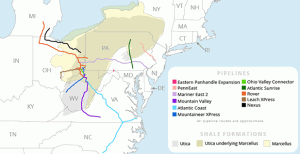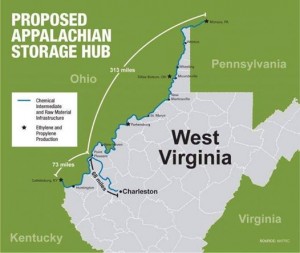“Pipeline-Plus” is a collection of tools/applications to allow the user the ability to search and gather information that WVGES has available about oil & gas wells in West Virginia. The following tools/applications are available within the system.
Oil & Gas Well Data Search: (Detailed Help) This application allows the user to query oil & gas header records in our system through the given fields on the form. The queries include a combination of numeric, character, pull-down and checkbox searches. Once the user enters their selection criteria and hits the search button, the matching header records are then returned. Latitude and longitude coordinates for wells are provided in NAD83 datum. The system will also provide a link to “pipeline” and other system applications to provide more complete well information if the data is available. Again, more detailed help on this application can be found here.
“Pipeline“: The Survey’s “pipeline” system provides public access, through a Web browser, to oil and gas well data for more than 134,000 oil and gas wells. The data are keyed on the well’s API number, which consists of the state code, county code, and permit number for the well. Data contained within tables include: locations; completions; farm name and operator; pays and shows of hydrocarbons; monthly and annual production of gas and/or oil, generally since 1979; formation tops and thicknesses; plugging; data about mechanical logs on file in the Survey’s log library as well as access to selected scanned well log images; and data about well samples and cores in the Survey’s core library. UTM and latitude/longitude coordinates for wells are provided in NAD83 datum. Users of the “pipeline” system select the county from a menu, enter the permit number, and select the desired data type(s). The data are then displayed on the user’s computer screen.
Scan Viewer/Download: (Detailed Help) This application allows the user to search and view electronic files which WVGES has available. File types currently in the system include scanned logs (wireline logs), digitized logs, well plats, completion reports, plugging affidavit, core photographs, well sample descriptions, batch cover sheets, and well permits. Most files available are of type .tif, .jpg, .las or .pdf. Fields available for query are well API number, file type, county, batch date and file modified date. Once the user enters their selection criteria and hits the search button, the matching records are then returned. A view link will be available to view or download the file. Please note that depending on the software on your computer, viewing of a file may open in the internet browser, a different application, or you may be prompted to save the file. We advise you to save Scanned Logs (wireline logs) and not try to view them directly because of the size of the files. To save files, right-click the view link and select the save option. It may also appear as “save target as”. Again, more detailed help on this application can be found here.
Slabbed Core Photos: This is a listing of all wells for which we have slabbed core photographs. These are listed by well API number. The page provides the number of images we have for the well, which mostly appear in one foot intervals. It also provides a link to our core viewer application to see or download the photographs.
File Repositories: This is an HTTP file server that allows the user to navigate the directory structure to download or view the file(s) of interest. Currenlty we offer scanned well logs, digitized logs, slabbed core photographs, well sample descriptions, and other E-files (scanned plats and completions). We advise you to save Scanned Logs and not try to view them directly because of the size of the files. To do so, right-click the image of interest and select the save option. Then you can direct the file to a location of your choice. Please note these images vary in size and some may take several minutes to download, especially if using a 56k or slower dialup connection. Generally files are organized in county folders with some exceptions.
If you have any questions or comments about the Oil & Gas Well Information System please (E-Mail) us with your questions or comments.
>>>>>>>>>>>>>>>>>>>>>>
 WVDEP Launches Webpage Dedicated to Helping Citizens Learn About Pipeline Projects, April 2, 2018
WVDEP Launches Webpage Dedicated to Helping Citizens Learn About Pipeline Projects, April 2, 2018
SOURCE: WV Department of Environmental Protection
CHARLESTON, W.Va. (April 2, 2018) – The West Virginia Department of Environmental Protection (WVDEP) has launched an easy to use webpage designed to help citizens learn more about five major proposed or under construction natural gas pipelines.
The five pipelines that are the focus of the webpage are the Atlantic Coast Pipeline, Mountain Valley Pipeline, the Mountaineer Gas Company Eastern Panhandle Expansion Project, Mountaineer Xpress Pipeline, and the Rover Pipeline.
“We are making sure that anyone who has any questions about these pipelines can find those answers on one easy to use webpage,” WVDEP Cabinet Secretary Austin Caperton said. “People who live near these projects deserve to be able to find answers to their questions quickly, and WVDEP is providing this new webpage to help them do that.”
Available on the webpage is information such as detailed maps of the proposed route of pipeline routes and a link to WVDEP’s searchable online database where additional information such as any inspection and enforcement action and any permit modifications can be found. Also available are public hearing transcripts, responses to comments received at public hearings, and press releases about the pipelines. The page will be updated as more information on each pipeline becomes available. Citizens will also be able to submit reports of possible permit violations via this webpage.
Contact: Jake Glance, WV-DEP, (304) 926-0499 ext. 1335, Jacob.P.Glance@wv.gov
>>>>>>>>>>>>>>>>>>>>>>

